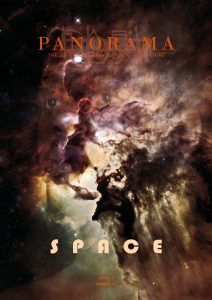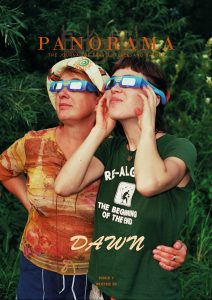“At Hawthornden Castle, it’s Thomas,” the American poet said as talk of ghosts persisted, referring to the renovated 17th century castle in Scotland serving writers from around the world. “He comes at night, just his head, and tries to carry on a conversation with you.”
“What does he say?”
“Nothing,” she said with a little shrug. “I think his tongue’s been cut out.”
We were sitting around an ancient oak table in the dining area of a mid-18th century Irish farmhouse, all seven of us: the poet from Arizona, a Canadian painter, a composer from the south of London, the Irish stage director and his cast of two, and myself, a playwright from the Southern states. Sharing tales of the supernatural and scaring the living daylights out of each other, we did not relish the idea of calling it a night. Instead, we stayed at the table, the gathering place at Annaghmakerrig, and continued to enthrall each other with strange tales, forgetting why we were there.
The farmhouse itself had started the frightening exchange. An artists’ retreat known as the Tyrone Guthrie Centre, it invites sessions as accompaniments to the art its guests are intent upon creating. Set on a hillside overlooking a freshwater pond, green pasture land, a copse of woods, and the rising hills beyond, Annaghmakerrig is a working dairy farm and residence for artists from around the world. It’s a skull-like structure of grey stone and mortar, with three floors of windows sitting blankly like eye sockets and a gaping oval door in front giving the skull a permanent sigh. The ancient ells and newer wings zag to the right and back, creating a mass of halls, rooms, and an inviting garden alcove off the kitchen/dining area. This last area was where we sat.
“This is so normal,” the Canadian painter remarked. He had been in residence at the artists’ colony for over six months, paying his way by tending the vegetable and flower gardens behind the main structure. “Every group on their first night here scares themselves half to death. The fact of the matter is this: the Gray Lady isn’t a spirit to be feared. She’s lonely; that’s all. I pity her.”
“The Gray Lady.” I had heard of her on my first trip to the Tyrone Guthrie Centre in 1986. Our group that time had also sat around the table, sharing encounters with the other world. It was a comfort knowing that in the years between my visits to Annaghmakerrig little had changed.
That first trip, I had been escorted to my quarters upon arrival by Bernard Laughlin, co-administrator of the facility with his wife Mary. Bernard told me that my quarters had been Sir Tyrone Guthrie’s private study and sleeping area, the room and bed where the great stage director had passed over the River Styx. “Don’t worry,” Bernard had assured me, “Sir Tyrone’s spirit makes only occasional calls. I fear that he and the Gray Lady don’t get along. But if he should visit during your stay, you’ll surely know it. Sir Tyrone was quite large upon his demise, and he requires the whole of the bed.”
I think Bernard was joking; I can’t be sure.
Talk of the Gray Lady that first trip had more or less been the same as my second. Her presence was felt even when she wasn’t around. Lar Redmond, an Irish novelist, storyteller and radio personality from Dublin, would sleep with his bedside lamp on. It was his way of keeping the Gray Lady from paying him a visit.
That first visit, I had walked the halls of the facility, studying the pictures that hung on the walls in an effort to discover some manifestation of the Gray Lady’s essence. There was none. Perhaps it had been Lar’s light that had kept her from making an appearance during my initial stay.
The second trip to Annaghmakerrig felt different. First of all, Bernard and Mary were away on holiday. I felt less safe in their absence. Second, the Canadian painter was a believer of another sort, not in Lar’s league at all. Well into his residence at the colony, he had been driven from his room, he claimed, by a Gray Lady visitation. It had been the middle of the night, and he had rushed through the twisting halls into the perceived safety of the kitchen and its numerous talismans, only to discover two of the other guests, both women writers, sitting at the dining table sharing a pot of tea. Noting their shock, he realized that in his dash from his room he had forgotten to don any clothing. There he stood in his natural glory, with a growing respect for the power the Gray Lady held. After that, he slept in his pajamas and hung a shaman, an American Indian handmade pouch of beaded leather, from the railing going up the stairs in the middle of his room. It contained the spirit of a fox, he said. His theory was that one spirit would not invade the space occupied by another.
Among the tales told around the dinner table that night were stories of hauntings of other noted homes. There were eye-witness accounts, silly coincidences, unexplained phenomena, and so on. But it was the Gray Lady that captured our fancy. After all, we were in her haunt, and we wanted to know more about her, our curiosity feeding our rising paranoia.
Little is known about the Gray Lady or why she has selected Annaghmakerrig as her site. According to Bernard, there is no record of a woman’s death on the premises. Where she came from was a mystery. That he did not deny her presence when queried was perhaps the most telling thing of all.
The Gray Lady earned her name as a result of a sighting made over a hundred years before. The spirit was described as a grey haze in the form of a woman rushing down a corridor and through a wall. Few actual sightings have been made since, but her visitations have continued to cause residents, guests, and employees cause for momentary fright. As the Canadian painter, the most experienced Gray Lady observer among us, explained, “She’s not out to harm anyone. If she had wanted to do that, she’s had ample opportunity to do so in days past. I’m convinced that all she wants to do is make contact. It’s as if she would like us to know something important.”
I wanted to laugh when he said this. “If you genuinely believe that she has something to communicate to us, why then place a so-called ‘shaman’ in your room?”
“One can’t be too sure of spiritual intentions,” he replied.
“What we should do,” the Irish actress said, her eyes bristling with excitement, “is stage a séance. Let’s invite her to us and take a look-see at what she has to say.”
“We tried that several months ago,” the Canadian said. “We got nowhere at all. The Gray Lady moves to the beat of her drum, not ours.”
The month of May in Ireland can be blustery. That night, the first night of my second trip to Annaghmakerrig, was no exception. Rain blown parallel to the ground by a stiff wind pelted against the large window in my room. It was bone chillingly cold. I could not get warm, try as I might.
To beat the cold, I crawled fully clothed into bed. I’d initially intended to read but soon switched off the light and went to sleep.
I awoke with something cold and slippery inching down my chest. And something else was tap tap tapping at the large oaken desk where during my first visit to the colony I had written the first draft of a new play. On this trip I hadn’t sat at the desk at all, nor typed on the ancient Royal typewriter provided gratis by Bernard and Mary. And yet, I clearly heard the tapping of the typewriter.
I glanced across the room. A dull reddish glow was hovering above the chair’s padded seat as the tap tap tapping continued. It was as if it were trying to use the ancient typewriter to tell me something.
I switched on the overhead light.
The tapping stopped. The red glow was gone. The wet chill sending goosebumps up and down my chest was my own sweat. Yet, I was shivering from the room’s damp cold. How could I sweat while I felt icicles forming from my toes?
It had stopped raining, but the wind whipped around the corners of the ancient house, bringing to mind the embellishments of Hollywood horror films. Such a cliché was worthy only of Boris Karloff or Vincent Price, but in this instance, I was living it.
I checked the desk and typewriter. The seat of the chair was cold. There was no message left in the typewriter carriage. I checked the bathroom, then the corridor outside my room. Total silence. All of Annaghmakerrig except for me was seemingly asleep.
I returned to my room, locking the door from the inside. I checked the locks on the large window overlooking the now-soaked garden. All securely locked.
This time, I went to bed properly, removing my clothing. But, remembering the Canadian’s tale of embarrassment, I decided to sleep in my underwear. I turned off the light and sought what little warmth I could find under the pile of blankets and quilts.
I jolted awake. Something the size of a tennis ball but with the weight of a hot air balloon had slapped me in the middle of my chest. And the tapping was back. So was the reddish glow, hovering slightly above the seat of the chair.
“What!” I said. Actually, I can’t vouch for that. I don’t know if I spoke or not. But I vividly recall hearing the word “What!” spoken in my bedroom that night.
I turned on the overhead light and the tapping stopped again. The red glow was gone too. I sat up, freezing. I didn’t dare go back to sleep.
I dashed to the bathroom, turned on the light, and left it on. I stood for a moment at the typewriter, contemplating rolling a sheet of paper into the carriage. I decided against it. I really didn’t want to know. Of course, as I relate this, I regret my decision. Who knows what I might have learned if only I had dared? I returned to bed, and this I know I said aloud to the walls, the ceiling, the empty and cold fireplace, “I don’t really care, you know?”
I fell asleep immediately.
At breakfast, I considered keeping my night’s adventures to myself. After all, I know how I respond to others who claim to have experienced contact with another dimension: they must be liars or lunatics. Everyone at the breakfast table was observing silence. It was during my second cup of tea that I blurted it out: “I think I had a visit from the Gray Lady last night. Only she wasn’t grey. She was red.”
Immediately everyone wanted to know about it. When I came to the part about the reddish glow, the Irish director, a level-headed intelligent woman who has directed professionally throughout Ireland and the United States, said, “Yes. My room as well. I woke, and there was a reddish glow at the bathroom door.”
“I thought mine was a dream,” the Irish actress said. “There was a red glow above my fireplace hovering over the mantle.”
We sat in awe, waiting for others to acknowledge their faulty sleeping from the night before. Nothing. We were the chosen three. Our descriptions of the reddish glow were identical. And we asked the obvious question, “What is it, do you think, that we might have seen?”
There was no answer. The Canadian shook his head. “Any of you who want it can have my shaman for a night.”
That evening our dinner was noticeably void of any discussion of spiritual manifestations. As soon as we had finished our meal, the Arizonan poet, the Irish director, the two actors, the English musician, and I decided it might not be a bad idea to hike the mile or so to the nearest pub.
I made a reacquaintance that night with the famous Irish whisky, Black Bush. We sat in the smoky pub until two in the morning, none of us caring to return to Annaghmakerrig for fear of what the Gray Lady might have in store for us. Finally, the proprietor drove us out the door. It was his bedtime, after all, whether we cared to sleep or not.
Back in the cold discomfort of Tyrone Guthrie’s study, I recalled Lar Redmond’s solution to the Gray Lady’s visits: I turned on the light in the bathroom and left it on.
She did not return.
The next morning, I booked an early return flight home. I had planned to stay two weeks. I lasted only two days. My sharing this is an admission: I had been “spooked” by something at Annaghmakerrig. It might have been the Gray Lady or merely something that I hadn’t digested well from the night before. Regardless, what I experienced was very very real, and I haven’t been back to the Tyrone Guthrie Centre since.
Lest I am mistaken, art happens far more regularly at Annaghmakerrig than encounters with the spiritual world. My first visit there prompted me to write an award-winning play of which I am most proud. Also in that first visit, I had the pleasure of meeting not only Lar Redmond, the novelist Catherine Brophy, and the Charabanc Theatre Company in the midst of preparing for a forthcoming Sligo production. Yes, strange things happen at Annaghmakerrig, but art is among them. I highly recommend a visit to the Tyrone Guthrie Centre, but if you go, remember to leave a light aglow. That or put a piece of paper in the ancient Royal typewriter in Sir Tyrone’s study. I’ll be interested to know what might be written there.











